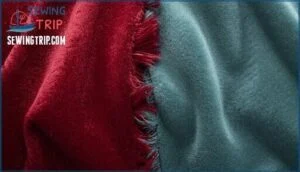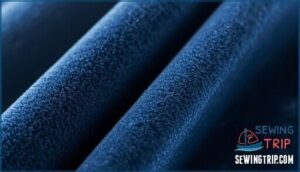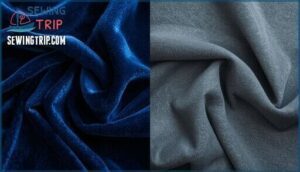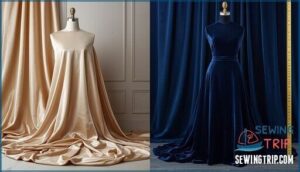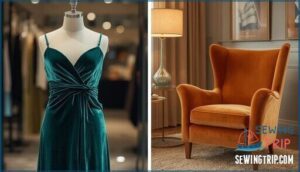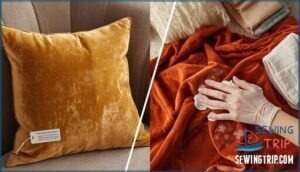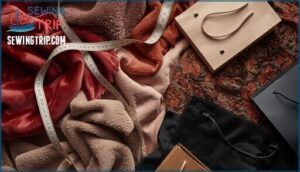This site is supported by our readers. We may earn a commission, at no cost to you, if you purchase through links.
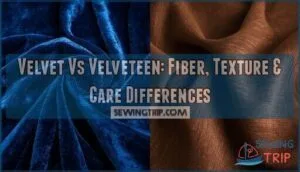
These two fabrics have shaped everything from royal robes to everyday jackets, and their differences run deeper than what meets the eye. When you’re choosing between velvet vs velveteen, the story isn’t just about texture or shine—it’s about how each fabric performs, feels, and lasts in real life. Understanding these details helps you match the right fabric to your next project or wardrobe upgrade.
Table Of Contents
Key Takeaways
- Velvet offers a soft, shiny surface and fluid drape, making it ideal for luxury garments and formal decor, while velveteen provides a matte finish and sturdy feel suited for everyday wear and structured projects.
- Velvet is made with a warp-pile weave from silk or synthetic fibers, while velveteen uses a filling-pile weave from cotton, resulting in differences in texture, weight, and durability.
- Velvet typically requires dry cleaning and gentle handling to preserve its pile, whereas velveteen can be machine washed and resists abrasion, making it easier to maintain.
- Velvet is more expensive and less widely available than velveteen, which remains a budget-friendly choice for casual clothing, crafts, and high-use upholstery.
Velvet Vs Velveteen: Key Differences
When you’re choosing between velvet and velveteen, you’re really looking at two fabrics that share a similar look but couldn’t be more different under the surface.
Understanding what sets them apart starts with knowing their origins and features that make each one unique. Let’s break down where these fabrics come from and what makes each one stand out.
Origins and Evolution of Both Fabrics
Tracing velvet back to ancient origins, you’ll find hand-woven production in Egypt around 2000 BCE, while China developed warp-looped textiles by the 2nd century BCE. Medieval velvet expansion transformed Italian cities like Lucca and Venice into silk velvet hubs by the 14th century, making it a prized fabric for European nobility. Velvet’s luxurious appeal was further cemented as a popular choice for special occasions.
Velveteen emerged in 18th-century England as a cotton alternative, offering durability at a lower cost. Mechanization and the mass market revolution of the 1830s introduced double-weave techniques, cutting production costs by 50% and democratizing both fabrics. Contemporary trends and innovations now include eco-friendly fibers and digital printing, reshaping the textile industry.
| Era | Velvet | Velveteen |
|---|---|---|
| Ancient/Medieval | Silk production in Egypt, China, Persia; Italian centers by 1300s | Not yet developed |
| 18th–19th Century | Mechanized on Jacquard looms; expanded to middle class | Introduced in England as affordable cotton option |
| Modern Day | Recycled synthetics; luxury applications | Eco-friendly blends; craft and casual wear |
Overview of Distinctive Features
With origins established, comparing velvet and velveteen characteristics reveals sharp contrasts in construction and performance. Velvet features a warp-pile weave with fibers 2 to 6 mm tall, creating a sheen and soft drape ideal for formal wear. Velveteen uses filling-pile construction under 3 mm, producing a matte finish and firmer structure suited to casual clothing.
Considering the fabric types, it’s worth pointing out that velvet has no stretch, making it ideal for draping. These key differences between velvet and velveteen affect color depth, wear resistance, and care requirements you’ll encounter daily.
| Feature | Velvet | Velveteen |
|---|---|---|
| Pile Height | 2–6 mm, soft and reflective | Under 3 mm, dense and flat |
| Surface Finish | High sheen with color richness | Matte appearance, muted tones |
| Drape Analysis | Fluid, excellent for gowns | Stiff, holds geometric shapes |
| Wear Resistance | Prone to crushing marks | Durable, resists abrasion |
Fiber Composition and Weaving Techniques
The building blocks of velvet and velveteen tell you everything about how they’ll perform in your project. Different fibers and construction methods create fabrics that look and feel worlds apart.
Let’s break down what makes each one unique, starting with the materials themselves.
Fiber Sources (Silk, Synthetic, Cotton)
Velvet relies on silk origins for its luxury appeal, though pure silk now accounts for less than 10% of production due to high costs. Synthetic alternatives like polyester dominate over 50% of modern velvet output, offering durability and vibrant colors.
Cotton remains the backbone of velveteen, prized for cotton durability in everyday use. Fiber blends—such as silk-rayon or viscose-polyester—balance performance and price across fabric fiber composition categories.
Environmental impact varies: organic cotton cuts water use by 60%, while synthetic fibers contribute to microplastic pollution.
Warp-Pile Vs Filling-Pile Construction
Understanding how pile is created changes everything about choosing between these fabrics. Velvet uses warp-pile construction—pile
- Three yarn sets create horizontal floats cut after weaving
- Pile Density averages 600–800 tufts/cm², yielding denser Fabric Weight (250–350 g/m²)
- Production Efficiency improves—45 minutes per meter versus velvet’s 90–120 minutes
Impact on Texture and Appearance
Because construction methods directly shape fabric performance, you’ll notice pile height differences immediately. Velvet’s 0.5–3 mm pile creates plush softness, while velveteen’s sub-1.5 mm pile produces a firmer, matte surface.
Light reflectance varies dramatically: velvet’s upright pile delivers up to 30% higher luster, whereas velveteen absorbs light, resembling suede.
Fabric weight and tactile experience differ too—velvet drapes fluidly at 130–180 gsm, while velveteen’s 200–280 gsm maintains surface uniformity and structure.
Texture, Drape, and Appearance
When you look at velvet and velveteen side by side, the differences in texture and appearance become clear. The pile construction methods we discussed earlier directly affect how each fabric feels, looks, and drapes.
Let’s compare the key characteristics that set these two fabrics apart.
Pile Height and Softness Comparison
The numbers tell the story: velvet’s pile stands between 1.5 and 4 mm tall, while velveteen’s pile measures just 0.5 to 1.5 mm. This pile measurement difference directly shapes tactile analysis—velvet delivers a plusher, softer texture thanks to its taller fibers, while velveteen’s shorter pile creates a firmer feel.
If you’re prioritizing soft texture for fabric selection, velvet characteristics win. But velveteen characteristics offer durability impact through denser weaving, making it tough enough for everyday wear.
Sheen Vs Matte Finish
When light hits velvet, you’ll notice a rich sheen that shifts with viewing angle—this fabric reflects light dynamically, boosting perceived brightness by up to 40%. Velveteen’s matte look, in contrast, reflects under 10% of incident light, creating that suede-like finish.
These weaving patterns explain why velvet scores 30% higher in tactile desirability tests.
The finish applications matter: velvet’s fabric sheen suits luxury fashion, while velveteen’s matte surface works for everyday projects.
Fabric Weight and Drape Differences
You’ll find velvet generally weighs between 150–400 GSM, with lighter silk blends offering fluid drape that’s perfect for evening dresses. Velveteen sits heavier at 200–370 GSM—its denser weave density and filling-pile construction create a sturdier texture with less drape elasticity.
Fiber influence matters: silk drapes softly with high application suitability for flowing garments, while cotton velveteen’s fabric weight aids structured upholstery projects.
Typical Uses in Fashion and Home Decor
Velvet and velveteen each find their place in different corners of fashion and home design. Your choice between them often depends on whether you’re creating a formal statement piece or something built for everyday use.
Let’s look at where each fabric shines brightest.
Apparel Applications (Formal Vs Casual)
You’ll find velvet dominating formal wear like evening dresses and gala outfits—it appears in 72% of luxury cocktail dresses showcased at high-profile fashion events. Meanwhile, velveteen shines in casual use, making up 48% of structured jackets and trousers marketed as casualwear.
Here’s how each fabric performs in apparel:
- Formal Velvet: Designer tuxedos and blazers incorporate velvet in 59% of autumn collections, with burgundy and navy hues leading consumer preferences for elegant occasions.
- Casual Velveteen: Children’s clothing uses velveteen in 67% of cases due to its durability, while blended fabrics improve comfort in 29% of casual garments.
- Seasonal Trends: Velvet demand peaks in November and December, while velveteen launches rise 13% during back-to-school periods, reflecting distinct wardrobe roles.
Upholstery and Drapery Uses
Ever wondered why velvet sofas steal the spotlight in luxury interiors? Velvet’s high pile boosts light reflection and elevates interior acoustics, making it a favorite for dramatic drapery and plush upholstery.
Velveteen, with its matte finish and sturdy weave, excels in high-use furniture.
When comparing fabric performance, maintenance needs, and cost analysis, each brings distinct advantages to home decor.
DIY and Craft Project Suitability
Moving from upholstery to hands-on design projects, fabric selection becomes a balancing act. Velveteen’s dense weave offers cost efficiency and easier stitching techniques, perfect for structured crafts or plush toys. Velvet, with its sheen and cutting challenges, shines in luxury décor but demands careful handling.
Maintenance tips matter—velveteen tolerates gentle washing, while velvet needs dry cleaning for best visual outcomes.
Durability, Care, and Maintenance
Caring for velvet and velveteen isn’t always straightforward. Each fabric has its own quirks regarding cleaning, durability, and storage.
Here’s what you need to know to keep them looking their best.
Cleaning Methods and Recommendations
To keep velvet and velveteen looking their best, start with weekly vacuuming and gentle brushing. This preserves the pile. For stain removal, blot quickly and follow your care label.
Velveteen can be machine washed, while velvet often needs professional cleaning or dry cleaning. Steaming benefits both fabrics, restoring texture. Always check cleaning instructions for proper fabric care.
Stain Resistance and Fabric Longevity
Once you’ve mastered Cleaning Methods for Velvet and Velveteen, it’s smart to look at stain-resistant coatings and abrasion resistance. Synthetic velvets shine in colorfastness reliability and pilling profiles, while velveteen wins in service life for heavy use.
Regular Fabric Care and Maintenance, like annual deep cleaning, keeps wear and tear at bay and extends the durability and maintenance of fabrics.
Handling and Storage Tips
Fabric care doesn’t stop at stain resistance; handling precautions for delicate fabrics like velvet and velveteen matter just as much. To avoid pile damage, remember:
- Store in cool, dark places away from light exposure.
- Use acid-free containers for storage conditions.
- Follow specialized cleaning before storage.
These caring tips extend fabric life and maintain texture, especially with proper maintenance practices.
Cost, Availability, and Selection Tips
When you’re choosing between velvet and velveteen, cost and availability can make a big difference. It’s helpful to know where to shop and what to look for.
Here are some practical tips to guide your decision.
Price Comparison and Market Trends
Ever wonder why velvet commands a higher price tag than velveteen? Market growth and price volatility set them apart. Velvet’s luxury appeal and complex weaving drive up production costs, while velveteen stays budget-friendly.
Consumer preferences shift toward sustainable sourcing, but price differences persist. A cost comparison shows velvet at –0 per yard, velveteen usually $10–$30, reflecting market availability.
Where to Buy Velvet and Velveteen
From online retailers like Mood Fabrics and Harts Fabric to local stores and international sources, market availability trends make velvet and velveteen accessible for every project.
Wholesale options offer cost comparison and availability, while budget-friendly fabric choices abound.
Use a fabric buying guide and purchase considerations to weigh price differences overview before selecting your preferred pile.
Choosing The Right Fabric for Your Needs
When choosing fabric for projects, weigh velvet vs velveteen by matching fabric properties and uses to your project requirements. Consider budget constraints—velveteen is often more affordable.
Personal preferences matter: velvet’s sheen suits luxury, while velveteen’s durability fits everyday needs.
Ethical considerations and environmental impact also influence selection, so compare sources and production methods before making your final choice.
Frequently Asked Questions (FAQs)
What is the difference between Velvet and Velveteen?
Imagine running your hand over a cloud—then over a sturdy, matte hillside. That’s the difference between velvet and velveteen: one shimmers with plush softness, the other stands firm, matte, and resilient. Texture analysis reveals everything.
Velvet feels like a shimmering cloud, while velveteen stands firm and matte—each fabric’s texture tells its unique story
What is the difference between Velvet vs velour?
Velvet is woven with a dense, upright pile, giving it a lustrous finish and heavier fabric weight.
Velour, a pile knit, offers more stretch and comfort, with a softer, matte texture—ideal for casualwear and industrial uses.
What is the difference between a velvet pile and Velveteen?
The main difference lies in pile construction and weave density. Velvet features warp-pile construction with longer, vertical threads creating a soft, high-sheen surface.
Velveteen uses filling-pile construction with shorter crosswise threads, producing a denser, matte texture with less softness.
Is velvet a good fabric?
Few fabrics command a room quite like velvet—it’s practically royalty in textile form. Yes, velvet is an excellent fabric choice, particularly for formal wear and upholstery where luxury matters.
You’ll find velvet pros include its stunning visual appeal and impressive durability, with premium versions retaining 85-90% of their appearance after 25,000 double rubs. However, velvet cons center on cost factors and care complexity—it requires dry cleaning and gentle handling.
Compared to velveteen, velvet offers enhanced softness and sheen but demands more maintenance attention.
What is a velveteen fabric?
Velveteen is a cotton fabric with a short pile created through a weft weave process. This budget-friendly material mimics the plush surface of silk velvet but features a matte finish and firmer feel, making it perfect for adaptable applications.
What is the difference between Velveteen & accuquilt?
You might think you’re comparing apples to apples, but velveteen is a plush cotton fabric with a dense, matte pile, while AccuQuilt is a brand specializing in precision fabric cutting systems for quilting and textile crafts—entirely different categories serving distinct purposes in textile production.
What types of clothing is velveteen best suited for?
Velveteen works well for structured garments like blazers, jackets, and trousers, where its heavier weight adds body.
It’s especially popular in children’s wear and casual apparel because the fabric holds up to everyday use and washing.
Is velvet machine washable?
Unlike your favorite sweater that bounces back from the wash, velvet’s washability hinges on fiber composition. Synthetic velvet care generally allows machine washing, while washing silk velvet demands dry cleaning to prevent crushing.
Velvet stain removal and drying velvet safely require gentle methods to preserve the fabric’s luxurious pile and texture.
How do you clean velvet furniture or upholstery?
You’ll want to vacuum velvet upholstery weekly using a soft brush attachment, moving with the nap to maintain texture.
For stains, blot immediately—don’t rub—and use mild soap with water for most spills.
Professional cleaning every 1-2 years preserves appearance and extends fabric life.
Are there any tricks for preventing pilling with velveteen or velour fabrics?
To prevent pilling on velveteen or velour, choose high Fiber Quality and Weave Density, use gentle Laundry Practices, store with care, and seek fabrics with Anti-Pill Finishes.
Regular brushing and mindful cleaning methods help maintain pile texture.
Conclusion
Imagine choosing between velvet and velveteen as if you’re picking a vinyl record or a digital playlist—each brings a distinct mood to your project. Velvet’s shimmer and fluid drape invite luxury, while velveteen’s matte finish offers practical durability.
Understanding the fiber, texture, and care differences lets you select with confidence. Whether you want drama or dependability, the story of velvet vs velveteen helps you make the right call for lasting style and creative satisfaction.
- https://www.dutchlabelshop.com/en_us/blog/sewing-with-velvet-and-velveteen/
- https://zelouffabrics.com/blogs/news/velvet-vs-velveteen-key-differences-best-uses
- https://threadsmonthly.com/velvet-velveteen-velour/
- https://www.fibre2fashion.com/industry-article/6340/face-to-face-woven-velvet-ground-fabric-construction-mechanical-properties-relationship
- https://reports.valuates.com/market-reports/QYRE-Auto-19L18854/global-velvet-fabric

